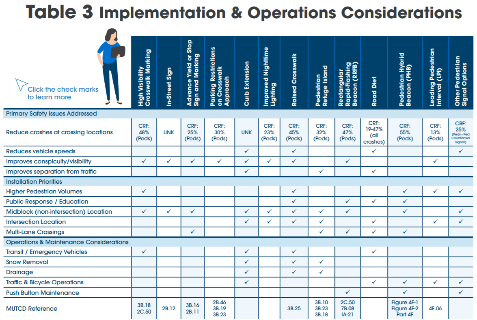The FHWA Guide for Improving Pedestrian Safety at Uncontrolled Crossing Locations has been applied to countless roadways, discussed in dozens of workshops, and referenced in several agency guidance documents since its release in 2018. The guide follows six steps to help the practitioner understand problems and identify potential countermeasures for improving pedestrian safety at unsignalized crossings. STEP Studio now brings the guide to life by allowing the user to click through the steps, digging deeper into supporting research, implementation case studies, and other FHWA guidance.

STEP table from the FHWA guide. (Source: FHWA)
STEP Studio, published in July 2020, links users to the dozens of key educational resources produced by the FHWA Safe Transportation for Every Pedestrian (STEP) program, such as countermeasure videos and tech sheets. STEP Studio also introduces new information, such as a matrix cross-referencing common design considerations with the “spectacular seven” countermeasures. This new “Table 3 Implementation & Operations Considerations” is a companion to tables found in the FHWA guide that associate roadway conditions and common safety problems with countermeasure options.
STEP Studio helps the practitioner to learn the basics of improving pedestrian safety at crossings, but it also offers insights into technical questions and research for the more experienced professional. For instance, it links to research reports that more thoroughly explain systemic analysis for pedestrian safety and FHWA guidance on overhead lighting. The tool is visually appealing and includes easy-to-use navigation options throughout. STEP Studio includes simple guidance for marking new crosswalks, including visual aids for describing considerations such as pedestrian travel time and stopping sight distances.
STEP Studio lists and answers frequently asked questions for each of the countermeasures, such as “When would a Rectangular Rapid Flashing Beacon (RRFB) generally be preferable to a PHB at a designated pedestrian crossing?” The resource also links to local and State agency guidance on topics such as crosswalk spacing, designing pedestrian refuge islands, and before-and-after evaluation studies.
The STEP program has produced more than 30 case studies, videos, and tech sheets on the countermeasures explained and promoted in STEP Studio. If you would like to learn how your agency can improve pedestrian safety with STEP, contact Becky Crowe at Rebecca.crowe@dot.gov with FHWA‘s Office of Safety, or Peter Eun at peter.eun@dot.gov with the FHWA Resource Center.

